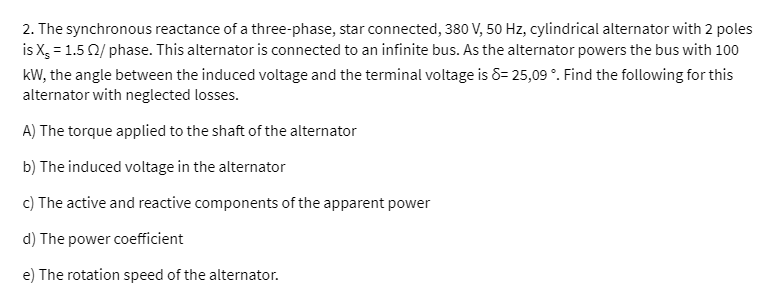2. The synchronous reactance of a three-phase, star connected, 380 V, 50 Hz, cylindrical alternator with 2 poles is X, = 1.5 0/ phase. This alternator is connected to an infinite bus. As the alternator powers the bus with 100 kW, the angle between the induced voltage and the terminal voltage is 8= 25,09 °. Find the following for this alternator with neglected losses. A) The torque applied to the shaft of the alternator b) The induced voltage in the alternator c) The active and reactive components of the apparent power d) The power coefficient e) The rotation speed of the alternator.
2. The synchronous reactance of a three-phase, star connected, 380 V, 50 Hz, cylindrical alternator with 2 poles is X, = 1.5 0/ phase. This alternator is connected to an infinite bus. As the alternator powers the bus with 100 kW, the angle between the induced voltage and the terminal voltage is 8= 25,09 °. Find the following for this alternator with neglected losses. A) The torque applied to the shaft of the alternator b) The induced voltage in the alternator c) The active and reactive components of the apparent power d) The power coefficient e) The rotation speed of the alternator.
Power System Analysis and Design (MindTap Course List)
6th Edition
ISBN:9781305632134
Author:J. Duncan Glover, Thomas Overbye, Mulukutla S. Sarma
Publisher:J. Duncan Glover, Thomas Overbye, Mulukutla S. Sarma
Chapter11: Transient Stability
Section: Chapter Questions
Problem 11.19P
Related questions
Question
100%
i want the answer for just for them thanks
d) the power coefficient
e)the rotation speed of the alternator

Transcribed Image Text:2. The synchronous reactance of a three-phase, star connected, 380 V, 50 Hz, cylindrical alternator with 2 poles
is X, = 1.5 0/ phase. This alternator is connected to an infinite bus. As the alternator powers the bus with 100
kW, the angle between the induced voltage and the terminal voltage is 8= 25,09 °. Find the following for this
alternator with neglected losses.
A) The torque applied to the shaft of the alternator
b) The induced voltage in the alternator
c) The active and reactive components of the apparent power
d) The power coefficient
e) The rotation speed of the alternator.
Expert Solution
This question has been solved!
Explore an expertly crafted, step-by-step solution for a thorough understanding of key concepts.
Step by step
Solved in 2 steps

Knowledge Booster
Learn more about
Need a deep-dive on the concept behind this application? Look no further. Learn more about this topic, electrical-engineering and related others by exploring similar questions and additional content below.Recommended textbooks for you

Power System Analysis and Design (MindTap Course …
Electrical Engineering
ISBN:
9781305632134
Author:
J. Duncan Glover, Thomas Overbye, Mulukutla S. Sarma
Publisher:
Cengage Learning

Power System Analysis and Design (MindTap Course …
Electrical Engineering
ISBN:
9781305632134
Author:
J. Duncan Glover, Thomas Overbye, Mulukutla S. Sarma
Publisher:
Cengage Learning